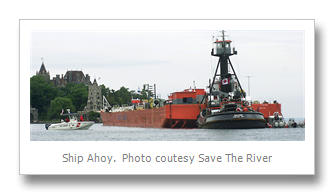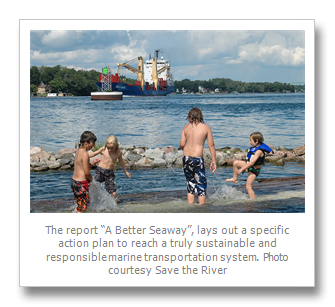After a long hard winter and a dreary, rainy past few months, spring has finally sprung on the River. The sun is shining, tulips are in full bloom, boaters are back on the River, and of course the St. Lawrence Seaway shipping season is in full swing.
Each year I have such conflicted feelings about the opening of the St. Lawrence Seaway. It’s a signal that warmer days are on their way even before the first robins have arrived. But, it also raises some of my deepest concerns about the impact of shipping on this magnificent River ecosystem.
As a kid, I thought ships were pretty cool. I loved squealing as my dad bounced the boat over ship wakes. I loved watching a ship go by and running to the water with my inner-tube and waiting for a chance to ride the big waves to shore. And, one of my fondest River memories is of spending an early foggy morning with my grandfather at the Thousand Island Park pavilion. We could hear ships in the distance with their regular booming horn blasts in the fog and I remember sitting quietly in amazement as a ship slipped by in front of us peaking in and out of the fog.
Thanks to my position here at Save The River, as Executive Director, I’ve had the chance to board a ship, one in the FedNav fleet, and was fortunate to have a tour guide from the company who patiently answered my seemingly endless questions. I had a chance to peer into the humungous cargo holds, ogle the gigantic engine, and admire the view from the Captain’s perch.
On that tour, I also peered into the ballast tanks, learned about ship emergency response plans, watched a Coast Guard inspection, and had a chance to ask tough questions about the shipping industry’s impact on the St. Lawrence River. As colorful as they may be, ships have brought significant problems to the River – from aquatic invasive species like zebra mussels and round gobies to serious oil spills and habitat damage. As I have learned more and more about their impact on the St. Lawrence River, my view of the ships that once were so fun has become tarnished.
When I look at a ship today, I first look to see if the ship is carrying the ‘bravo’ flag - a red flag with a notch cut out on the end – which means the vessel is carrying hazardous cargo. Very little is disclosed about what is considered ‘hazardous’ but I have learned that the list of materials is long and includes everything from sodium chloride (salt) to gasoline and heavy fuel oil to extremely dangerous chemicals like benzene. I think about the ship’s history of groundings next. Every time a vessel that has run aground in past years glides by heading for the narrows, I pause for a moment and hope that lightening won’t strike twice.
When I see a ‘saltie’, I wonder what critters might be stowed away in its ballast tanks. (Salties, ships that arrive from across the ocean, are the number one transporter of aquatic invasive species into the Great Lakes.) And then I think about the shipping industry lobbyists who are walking the halls of Washington, Ottawa, and Albany arguing vigorously against stronger ballast clean up rules to stop further invasive species introductions. I’m left wondering how things would look for our River and Great Lakes today if the shipping industry had spent their money on technology development for ballast clean-up systems rather than lobbyists paid to fight clean-up programs.

After five years here at Save The River spending more hours than I can count learning about ships and their impact on the St. Lawrence River and Great Lakes, my list of concerns about shipping impacts on the River still continues to grow. Shipping lobbyists and the Seaway are on record opposing the environmentally beneficial water levels plan (Plan B+) that our communities have been supporting for years. They’ve fought for (and unfortunately won) exemptions from federal rules to clean up ship smokestack emissions, making some of the Great Lakes ships among the dirtiest air polluters in the industry. And, the Seaway has unilaterally extended the shipping season on the St. Lawrence River, with no input from River communities, state or federal environmental and safety agencies, or elected officials.

As I look out my window at the gleaming blue waters of the St. Lawrence, I’m reminded of just how important this River is to all of us. We all have heard and know the stats… The Great Lakes and St. Lawrence River make up 20% of the world’s surface fresh water and 90% of North America’s surface freshwater. They are a drinking water supply for millions of Americans and Canadians. This River is the heart and soul of our communities, our way of life, and our livelihoods.
Unfortunately, the Seaway and shipping industry have vigorously resisted every effort that asks them to be more protective of the St. Lawrence River and Great Lakes. But after years of promising an economic boom to River communities that never arrived and more than 50 years of polluting our shores with oil spills and invasive species, and damaging critical fish and wildlife habitat, it’s time for the Seaway to make a good faith effort to work proactively to protect the St. Lawrence River and Great Lakes. For a few ideas, I’d suggest they start with the recommendations outlined by more than 50 environmental and conservation groups in the report “A Better Seaway”, which lays out a specific action plan to reach a truly sustainable and responsible marine transportation system. (Visit www.abetterseaway.org to learn more.)
At the end of the day, I’m a realist. Shipping will continue to be a part of the St. Lawrence River for a long time to come. But, I’m not willing to accept shipping on our River that continues to damage this magnificent resource. Instead, I hope to one day see shipping on the River that restores its tarnished image by embracing its role in protecting the mighty St. Lawrence.
By Jennifer J. Caddick, Save The River Executive Director & Upper St. Lawrence Riverkeeper
Originally from northeastern Pennsylvania, Jennifer has worked for a variety of environmental and conservation organizations in upstate New York and on the Chesapeake Bay. Since 2006, Jennifer has served as the Executive Director of Save The River and lives year-round in Clayton. Her family has spent time along the St. Lawrence River for many years and they are summer residents on Linda Island.